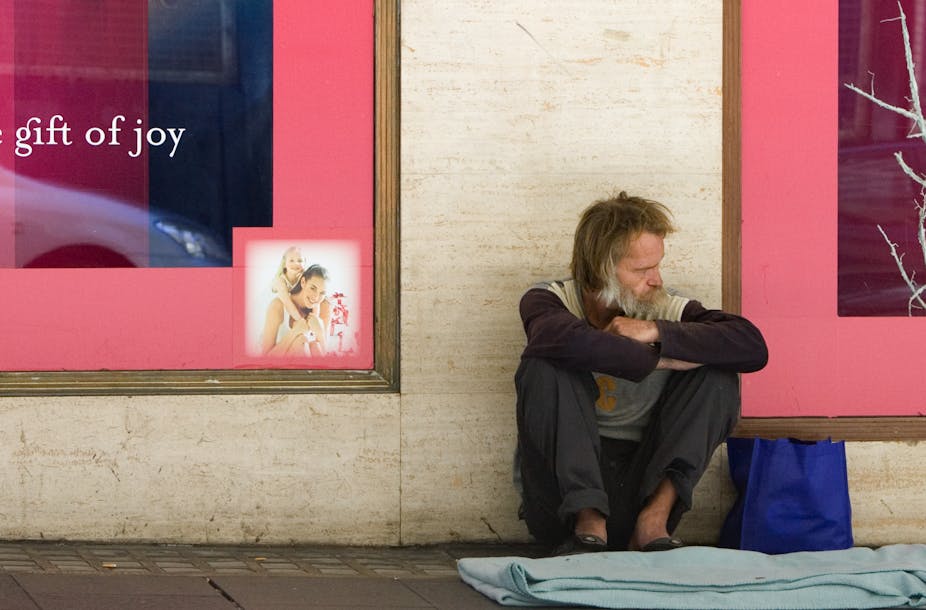“Politicians will talk a lot about ‘cost of living pressures’ during this election campaign, even though most people are enjoying living standards that are better than ever. However, a growing group of people are simply unable to afford the essentials. Poverty is on the rise.” - Australian Council of Social Service, Federal Election Statement 2013.
Someone who turned 18 just in time for Saturday’s federal election would have been born around the middle of 1995. Back then we were listening to Oasis and the Smashing Pumpkins, watching Toy Story and the X-Files, and basking in the glory of a great Australian cricket team. At the same time, 9.2% of people were living in a household whose income was less than half of the Australian median – a common measure of poverty. We know what happened over the intervening 18 years in the Ashes, but what about poverty?
Answering this question isn’t easy and comes down to on which side of the Poverty Wars you fall. On one side, there are those who argue that poverty is a relative measure. Whether or not a person is considered poor should take into account the standard of living of the general community. Others argue that we should follow more closely the US approach where poverty is measured in absolute terms or the inability to afford a particular basket of goods.
Which side you take will determine the way in which you assess the statement made by the Australian Council of Social Services (ACOSS) that “a growing group of people are simply unable to afford the essentials. Poverty is on the rise”.
The best way is to look at the proportion of the population, living in a household, whose income is below a certain threshold. For relative measures of poverty, this threshold is often for those whose income is below half of the Australian median. (If you earn the median income, you are in the middle - half the population earns more, half less). For absolute measures of poverty, it is necessary to fix the threshold at a certain value. There are no widely accepted absolute measures in Australia, so I will follow a reasonably standard approach and use the relative poverty line fixed at a certain baseline year (1994-95).
Using data from the Survey of Income and Housing, the following table gives the relative poverty line in Australia after adjusting for inflation. It also shows the estimated percentage of people who live in households that fall below that poverty line. The dotted black line gives the percentage of people who fall below the poverty line from the base year (1994-95).

Looking at the grey line, the level of income required to be above half-median income rose from $253 per week in 1994-95 (in $2011-12) to $395 per week in 2011-12. This reflects strong income growth over the last 18 years across the income distribution.
But, is poverty on the rise? In 1994-95, it was estimated that about 9.2% of people lived in a household that had an income that was less than $253 per week. By 2011-12, the dotted black line shows that only 3.3% of people lived in households below that threshold. A much smaller proportion of people lived in a household in 2011-12 that would have put them in income poverty in 1994-95. However, when taking into account changes in living standards, a much greater proportion of the population were living in relative poverty in 2011-12, rising to 12% of the population.
Other sources of data like the HILDA find a steadier relative poverty rate over the last decade, but no data sources show a decline in relative poverty that matches the rise in income over the period. It is also interesting to note that, according to the General Social Survey, 13.9% of adults in 2002 reported that they were “unable to raise $2,000 within a week for something important” compared to 13.3% in 2010.
Verdict
So, is ACOSS correct in saying that “poverty is on the rise”? That depends on how you measure it. What we can say though is that most people in Australia have a higher standard of living now than 18 years ago. But, there is still a significant minority of people who fall well short of the median income in Australia and who feel the ongoing effects of financial stress.
Review
Australia does not have a readily available poverty rate. It is measured either according to income levels or by a statistical computation which takes account of lack of access to resources in addition to income. The author uses an income-based approach.
Long-standing conventions in poverty research for affluent nations refer to relative poverty, while absolute poverty applies in nations where there is deprivation of the basics such as water, shelter, food, health care, sanitation. The author’s reference to absolute poverty and the ensuing calculations are problematic and, unintentionally in my view, could confuse rather than clarify.
Income-based poverty rates are calculated as either 50% or 60% of median incomes after housing costs. The ACOSS Poverty Report in 2012 used the 50% median income benchmark to find that 12.8% of the population (or 17.3% of children) lived in poverty in 2010.
The more frequent measure of income poverty (UK, Ireland Europe) is 60% of median incomes. Applying this benchmark in the HILDA Survey, the Australian income poverty rate has been consistently around 20-22% over the decade 2001-2010, according to Brotherhood of St Laurence and the Melbourne Institute of Applied Economic and Social Research.
In additon, measures of poverty as social exclusion take account of multiple deprivations of the resources/opportunities/amenities required to function in society. This rate of poverty as social exclusion has increased since 2008.
So, while it it correct to say that income poverty rates have remained stable over last decade within Australia’s growing population, the numbers of people experiencing deprivation of the basic opportunities/resources/amenities required to participate in society have increased.

